Large Healthcare & Hospital Systems Industry Report
Employee relations in large healthcare & hospital systems stands in a category of its own — defined by complexity, urgency and outcomes that can profoundly impact people’s lives. This report shines a light on these opportunities and offers actionable ideas to drive strategy and help build fair, transparent and healthy workplaces — so you can focus on what matters most: Delivering exceptional care for both patients and employees, while protecting your organization.
A Message from the CEO

Employee relations in large healthcare & hospital systems stands in a category of its own — defined by complexity, urgency and outcomes that can profoundly impact people’s lives. That’s why we created a special report focused on this segment. Organizations delivering care across multiple facilities and specialties face unique pressures. They must balance coordinated care, manage diverse teams, and respond to rising issues such as unprofessional conduct (related to both employees and patients), mental health challenges and increased union activity. These trends are further shaped by societal shifts and a rapidly evolving political climate with ever-changing regulations.
Our goal with this report is to provide actionable insights to help employee relations leaders navigate these challenges. Organizations are making strides in tracking key metrics and centralizing employee relations, reflecting a strong commitment to consistency and compliance. Yet the data shows there’s still room to grow — especially when it comes to proactively addressing risks, supporting training needs and adapting to the evolving challenges facing today’s healthcare workforce.
This report shines a light on these opportunities and offers actionable ideas to drive strategy and help build fair, transparent and healthy workplaces — so you can focus on what matters most: Delivering exceptional care for both patients and employees, while protecting your organization.
Thank you for your dedication to your teams, your patients and your employees. I invite you to explore the findings and join the conversation as we shape the future of employee relations in healthcare.
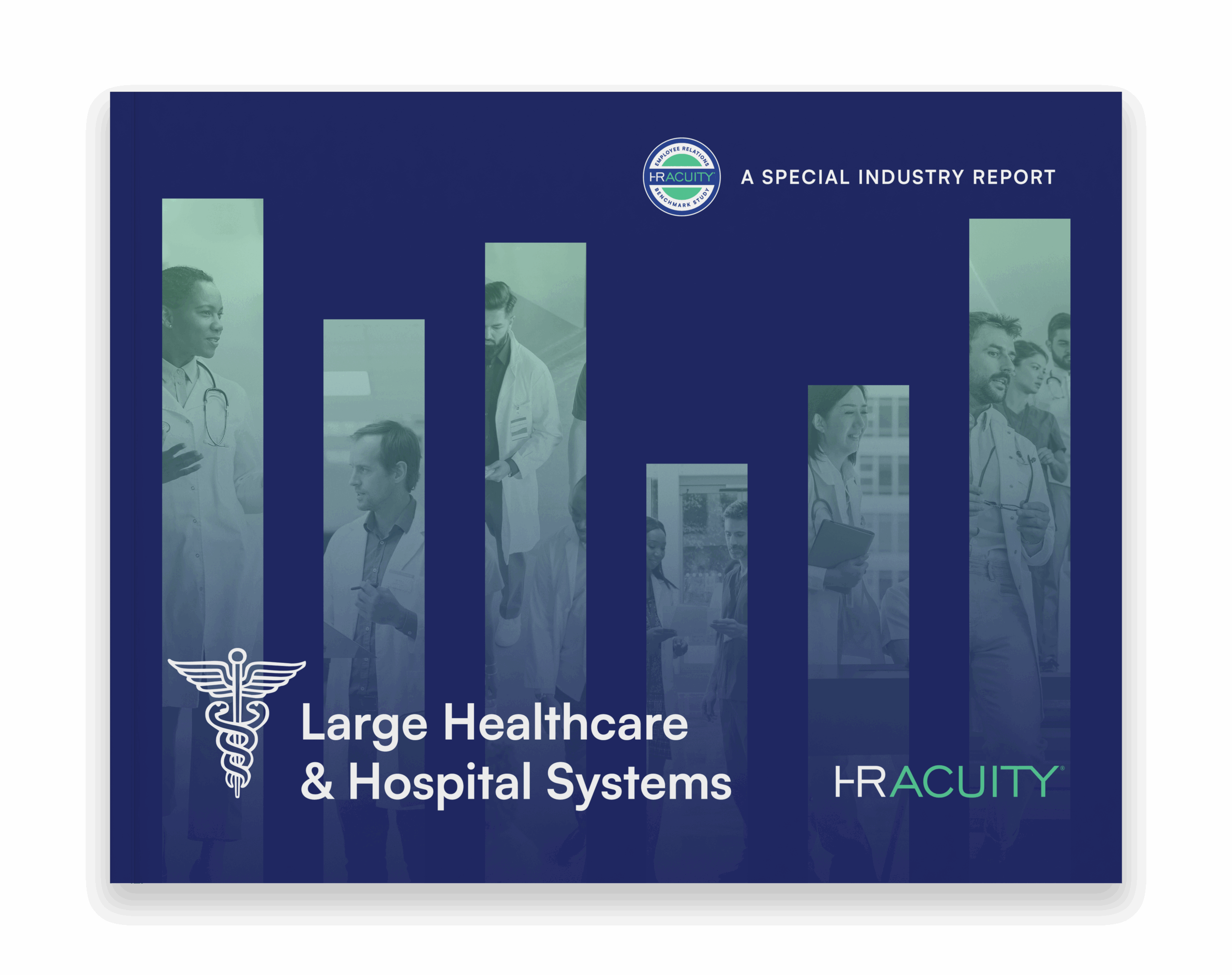
Deb Muller, CEO and Founder of HR Acuity
Respondent Profile
Large Healthcare & Hospital Systems Respondent Profile*
Organizations within the large healthcare & hospital systems sector typically provide a comprehensive range of services — spanning inpatient, outpatient and coordinated care across multiple facilities such as hospitals, clinics, physician practices, sub-acute and skilled nursing facilities, and other healthcare sites. These services are delivered under a single organizational umbrella, within an interconnected structure or through strong affiliations.
Findings include input from 10% of total respondents representing 29 large healthcare & hospital systems.
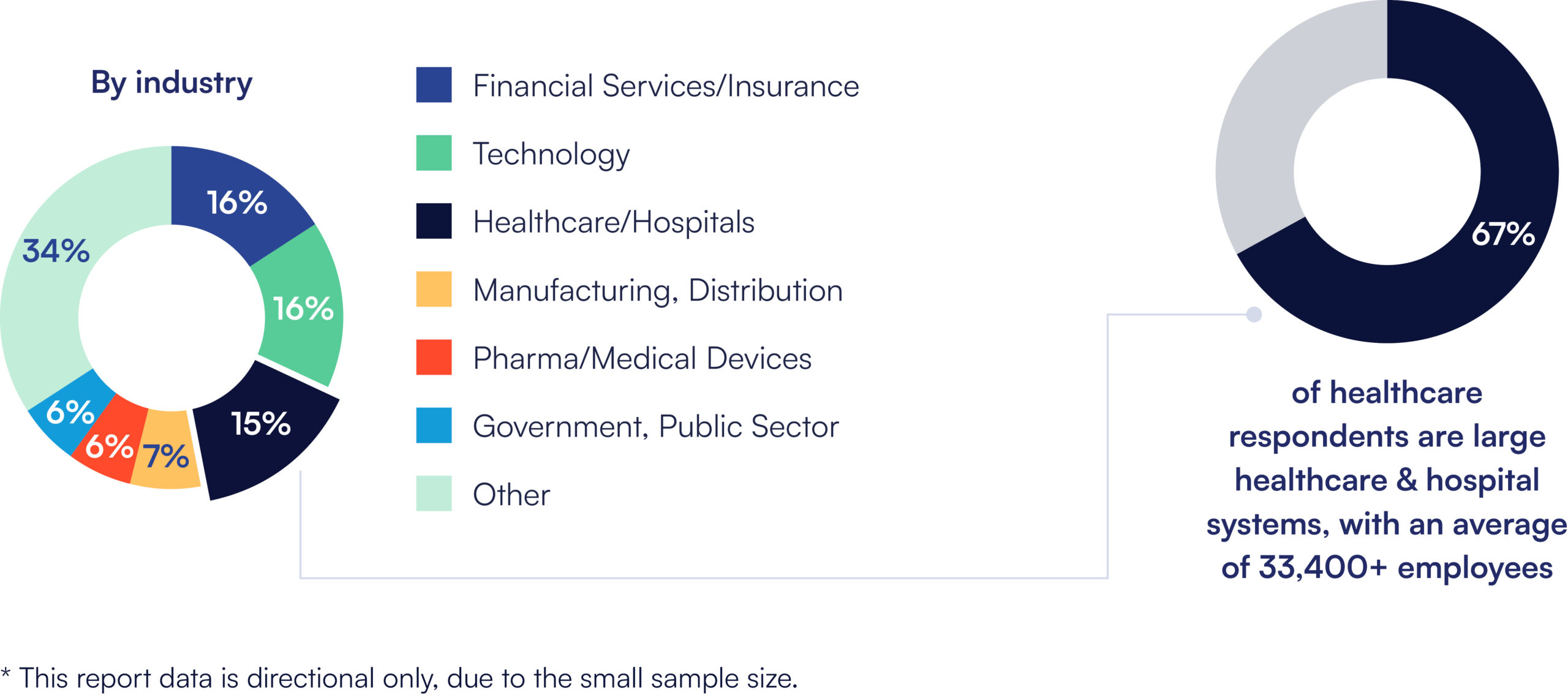
Key Findings
 Matching Resources to Evolving Needs
Matching Resources to Evolving Needs
These organizations stand apart from overall Benchmark participants in several nuanced ways, reflecting the unique complexity and pressures of healthcare environments. These organizations are more likely to assign cases by line of business and often operate with fewer dedicated employee relations resources per employee, perhaps because their employee relations function tends to be centralized (i.e., a team of Employee Relations Professionals or Center of Excellence (COE) responsible for managing employee relations issues and conducting investigations across the organization – may or may not be geographically centralized).
 Tighter Processes Can Safeguard Workplaces
Tighter Processes Can Safeguard Workplaces
While organizations in this segment show a strong commitment to tracking substantiation rates and integrating demographic, performance and other employee data, their use of formal investigation processes and data-driven insights and initiatives lags behind broader Benchmark participants. Large healthcare & hospital systems also report sharper increases in issues such as unprofessional conduct, mental health challenges, and union activity, which they attribute to heightened awareness of rights, societal pressures and the political climate.
 Bridging Data Gaps Can Help Reduce Risk
Bridging Data Gaps Can Help Reduce Risk
Despite leveraging technology for case management, there’s a notable gap in using data to predict employee behaviors and identify training needs, which impacts their ability to address emerging risks before escalation. These differences highlight the need for case management and workplace investigations solutions that can be tailored to address the distinct challenges faced by large healthcare & hospital systems. Such solutions are essential to ensure fairness, transparency and healthy work environments for all.
Organizational Model & Staffing Resources
Organizational Model and Case Assignment
Large healthcare & hospital systems tend to use a centralized or mixed organizational model and are more likely than overall participants to assign cases by line of business (often referred to as “service line” among healthcare organizations). This ensures that cases are handled by practitioners with specialized expertise, deep contextual knowledge and a thorough understanding of complex regulations as well as the challenges and unique operational needs of each department and service area. This approach can result in more effective investigations and better outcomes.
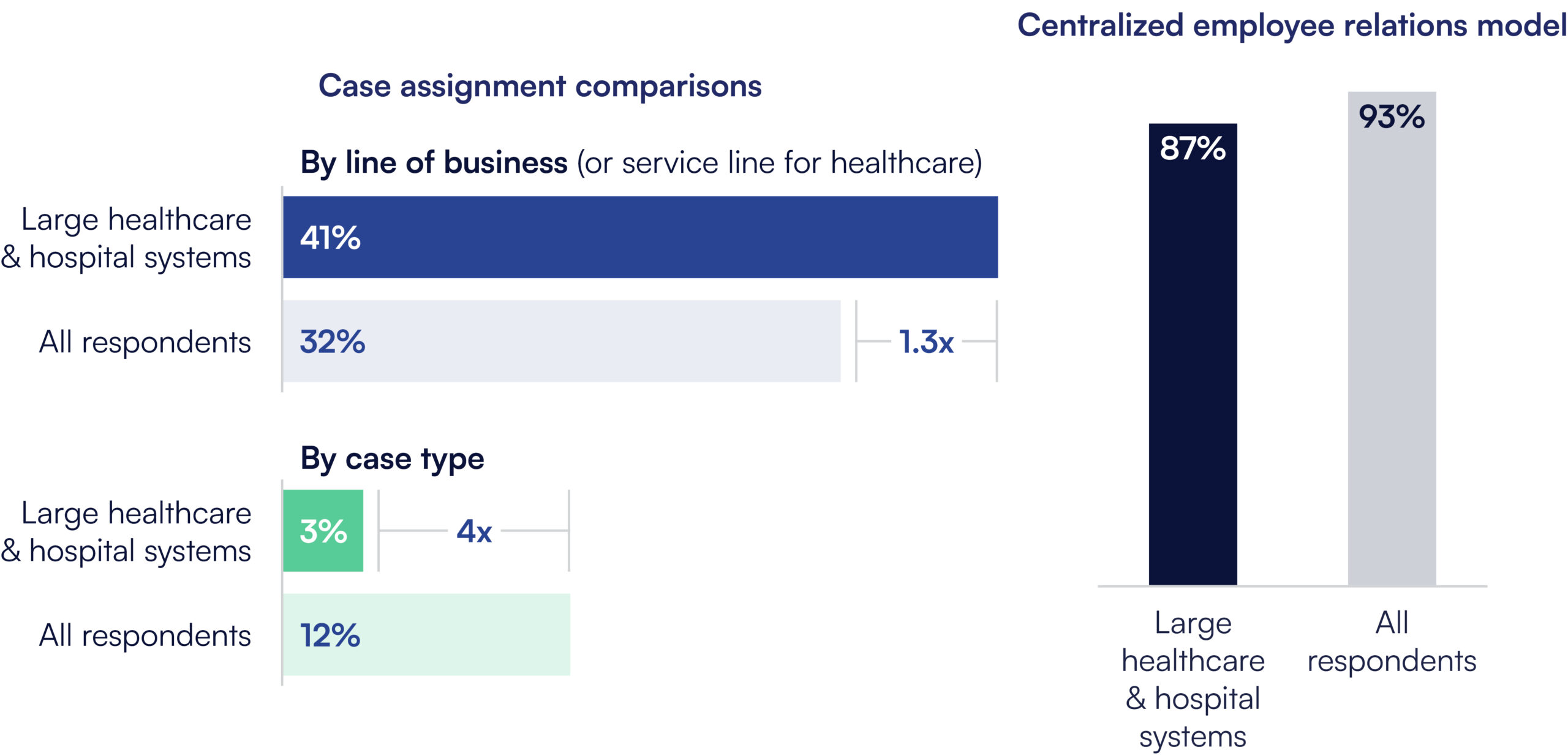
Staffing Resources & Scope
Compared to broader Benchmark respondents, many organizations in this sector have leaner employee relations teams, with a larger share also handling performance management. This stretches resources and can impact the quality and timeliness of investigations and issue resolution. Resource constraints also create an opportunity for case management technology to improve efficiency and consistency. Secure, AI-guided solutions enable leaders to address routine matters independently, freeing employee relations professionals to focus on high-risk issues and strategic initiatives. By linking caseloads, outcomes and risk mitigation, organizations can build a stronger case for additional headcount and use resources to their fullest potential.
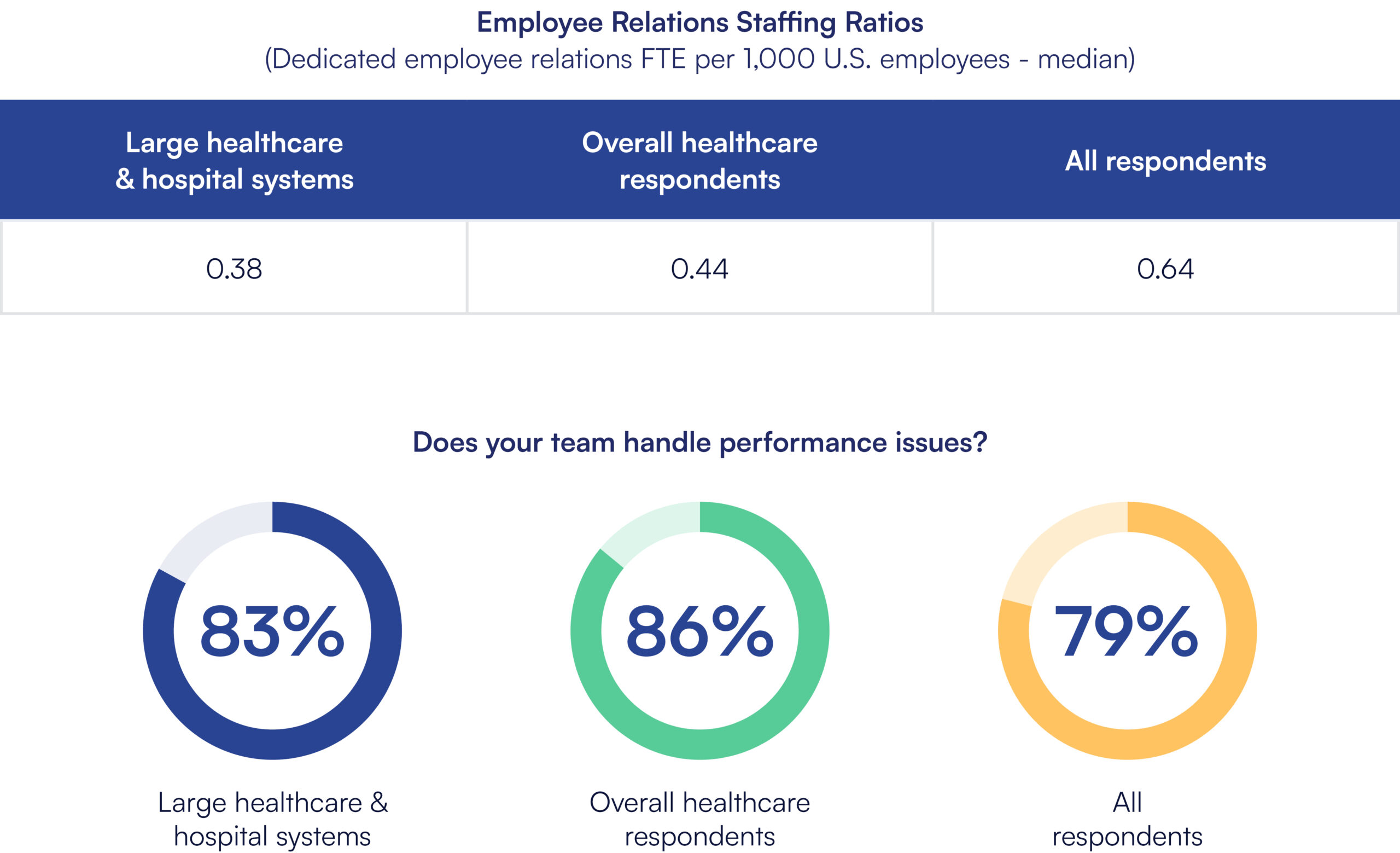
Issue Trends
Issue Reporting
Most organizations in this sector track whether issues are reported anonymously but stop short of analyzing the real numbers — how many issues are reported anonymously versus by name. Without this critical data, leaders lack a powerful lens into employee trust and the true climate of their workplace. To drive meaningful change, organizations must measure and share these trends to gain deeper insights into workplace culture and strengthen employee relations strategies.
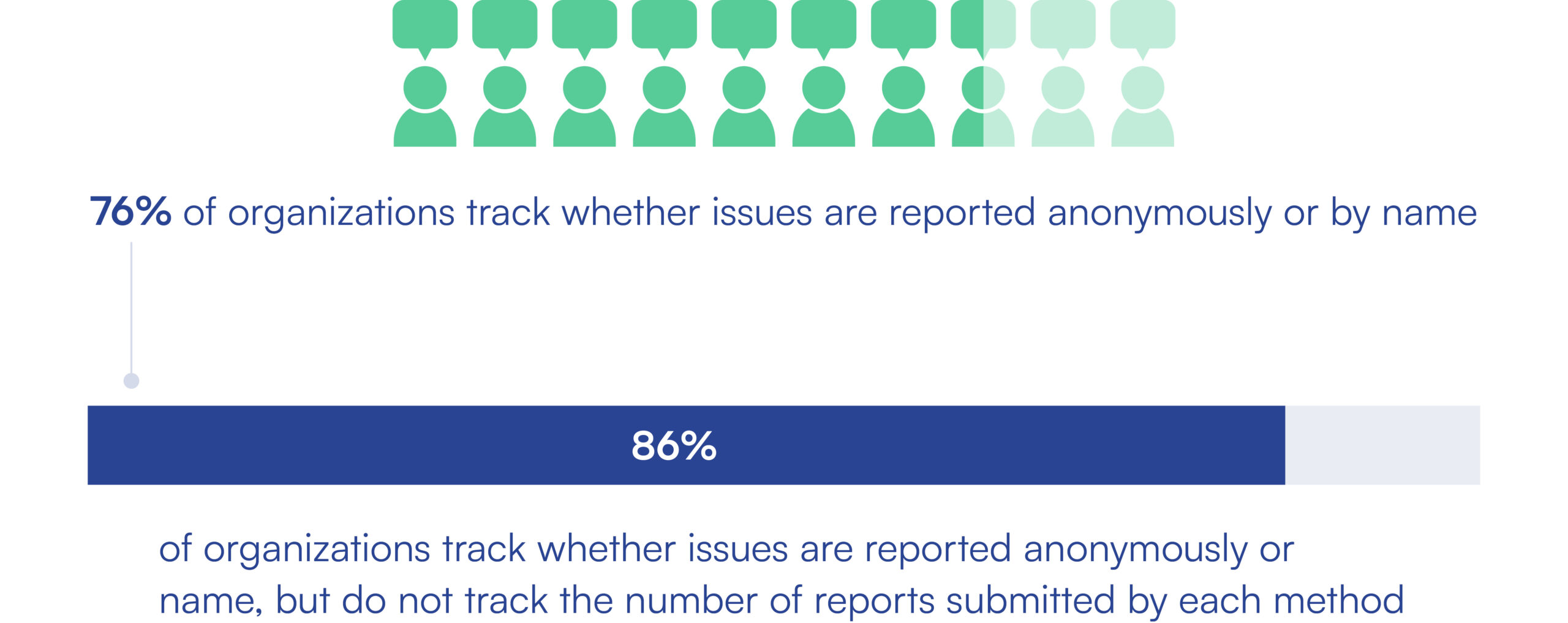
Issue Volume and Case Complexity
At first glance, case and issue volumes for large healthcare & hospital systems appear more favorable in comparison to all respondents, but the real story lies in the details of case complexity and issue tracking. Only one in 10 organizations tracked the number of issues per case, preventing an accurate picture of caseloads and creating challenges in resource allocation to ensure issues and investigations are handled effectively. As large healthcare & hospital systems face increasingly complex issues, leveraging technology to capture and analyze these nuances will provide the insights needed to uncover hidden patterns, address root causes and strengthen employee relations processes.
Only 10% of large healthcare & hospital systems track the number of issues per case.
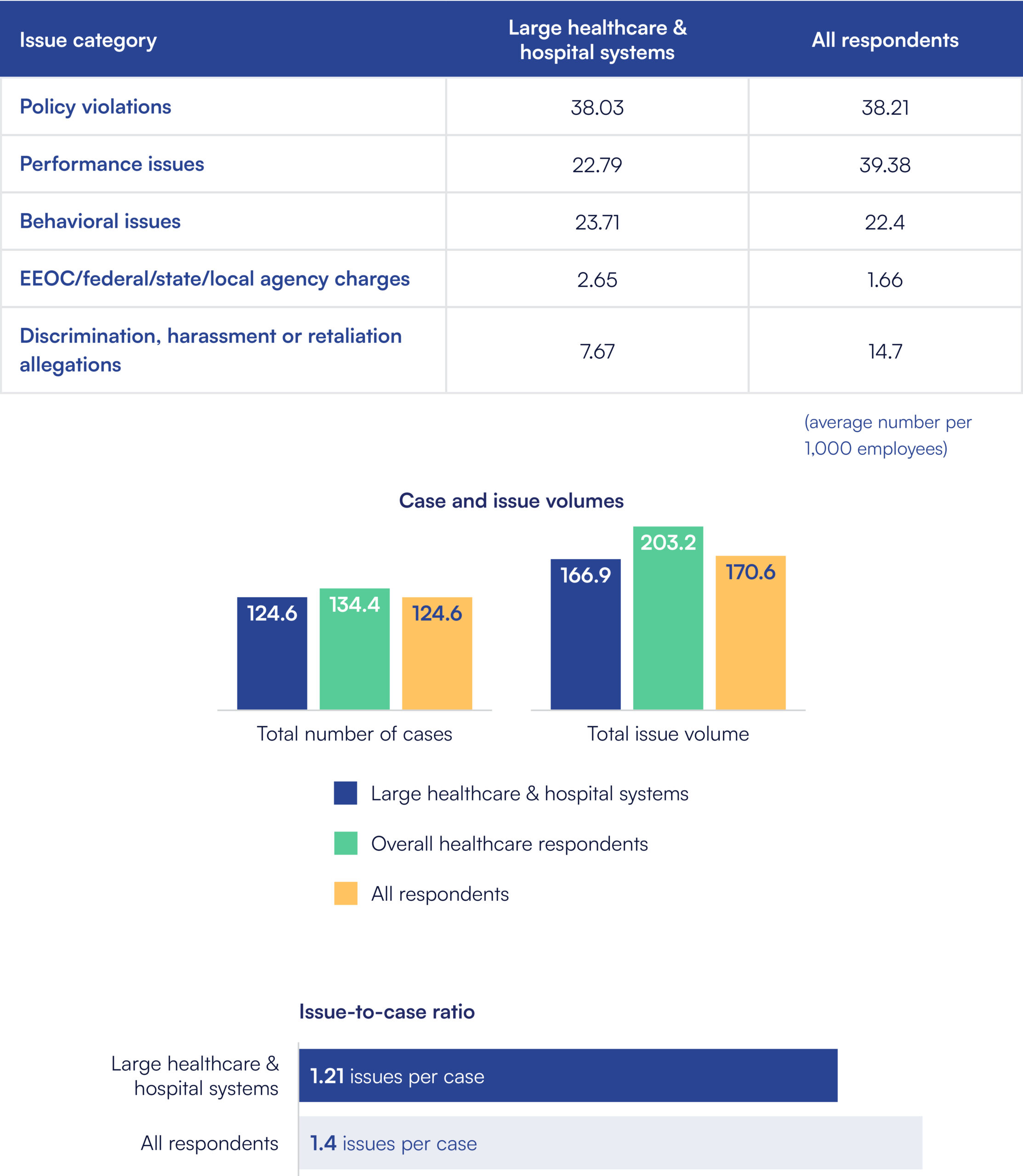
Issue Trends: Issue Volume by Case Type
This industry segment experienced significant increases across a wide range of issues, outpacing overall Benchmark trends in most categories in 2024. These increases reflect the growing complexity and risk in today’s healthcare environments and highlight the need for additional employee relations resources. Investing in tools that help leaders address issues before they escalate, along with solutions that enable proactive tracking and analysis of evolving issues and trends, is crucial for strategic interventions and to create safer, more supportive workplaces for employees.
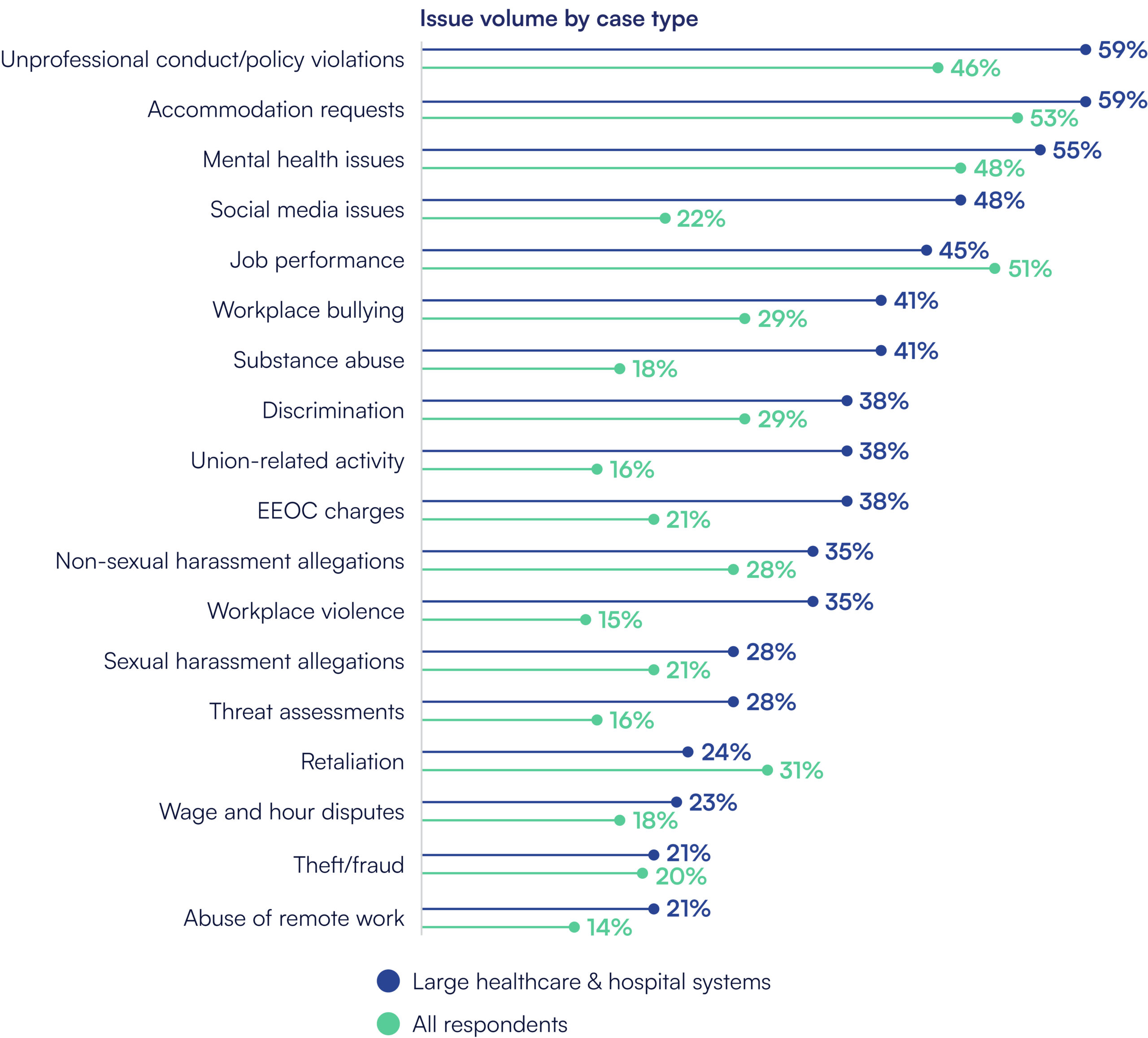
Issue Volume Attribution
More organizations in this sector saw heightened challenges driven by mental health concerns, the political environment and increased employee awareness of perceived rights compared to all respondents. These organizations also report greater impact from societal crises and generational differences compared to overall Benchmark participants. Navigating this complex landscape requires the ability to spot trends and issues in these areas and intentional focus on understanding the needs of employees from different generations and addressing the unique pressures impacting today’s healthcare workforce.
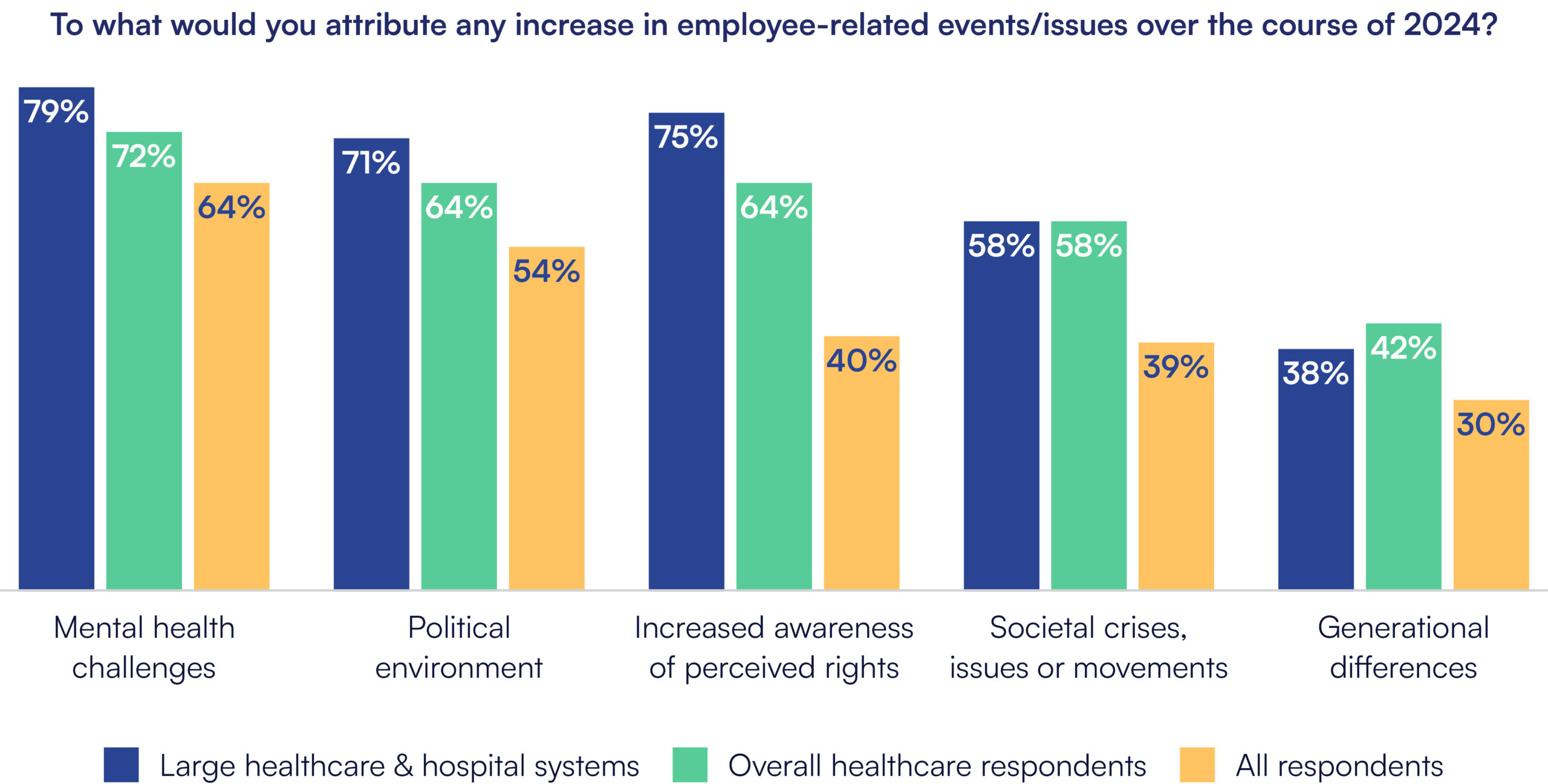
Time to Close
On average, most employee relations cases were resolved significantly faster for large healthcare & hospital systems than all respondents, particularly for policy violations, performance and behavioral issues. However, resolution times were longer for accommodations and responses to EEOC or other agency matters, suggesting unique complexities in these areas. This mix of efficiency and complexity underscores the need for streamlined processes to ensure timely, compliant outcomes in the demanding and high-stakes healthcare environment.
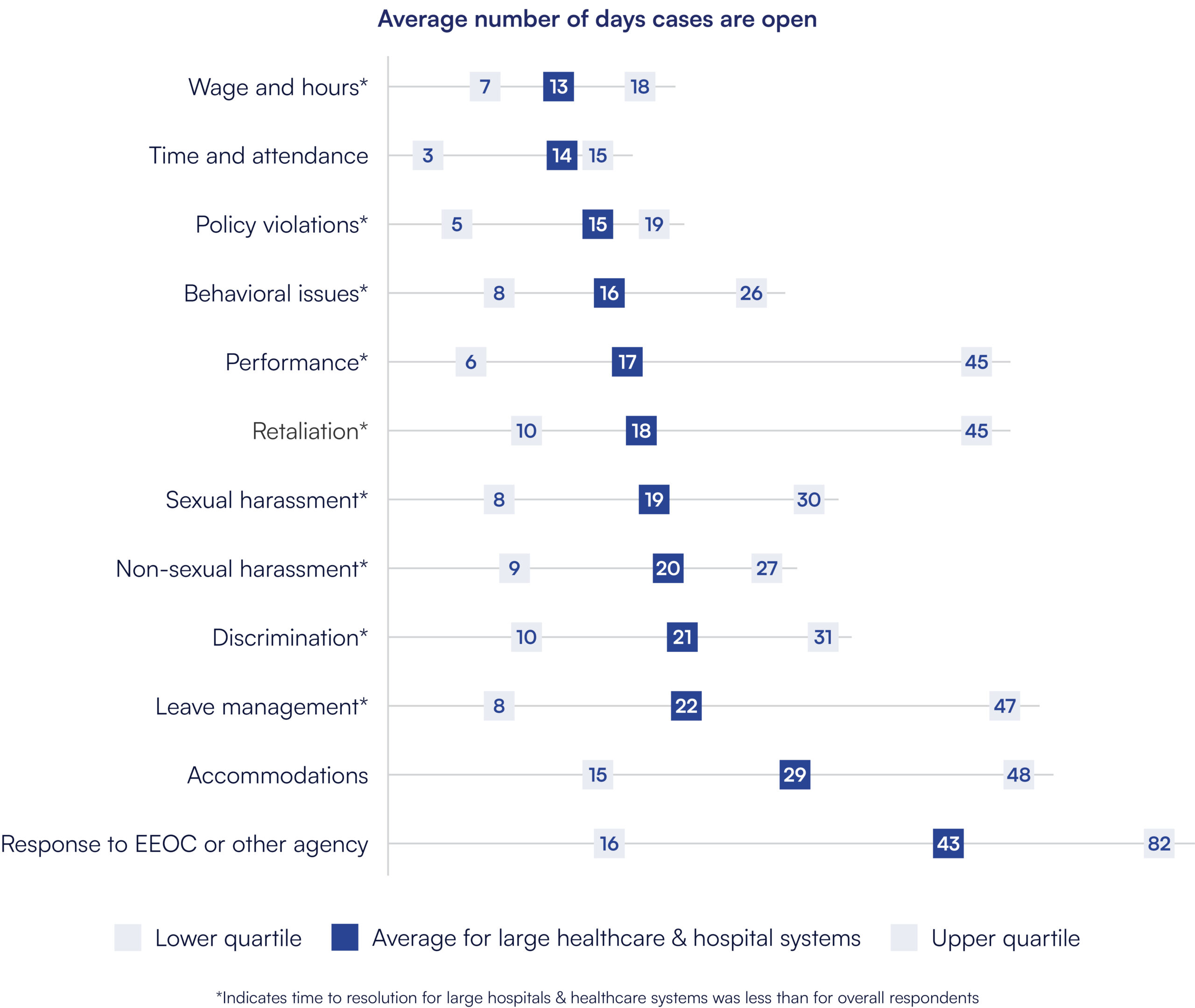
Investigation Processes & Outcomes
Investigation Processes
The use of structured investigation processes is far less common and often not required among large healthcare & hospital systems. Instead, many rely on suggested guidelines or operate without a defined approach. This leaves these organizations more vulnerable to inconsistencies and risk when handling workplace investigations. A clear opportunity exists to elevate practices by implementing standardized investigation protocols. Improvements in this critical area will lead to better outcomes for employees and reduce legal exposure for their organizations.
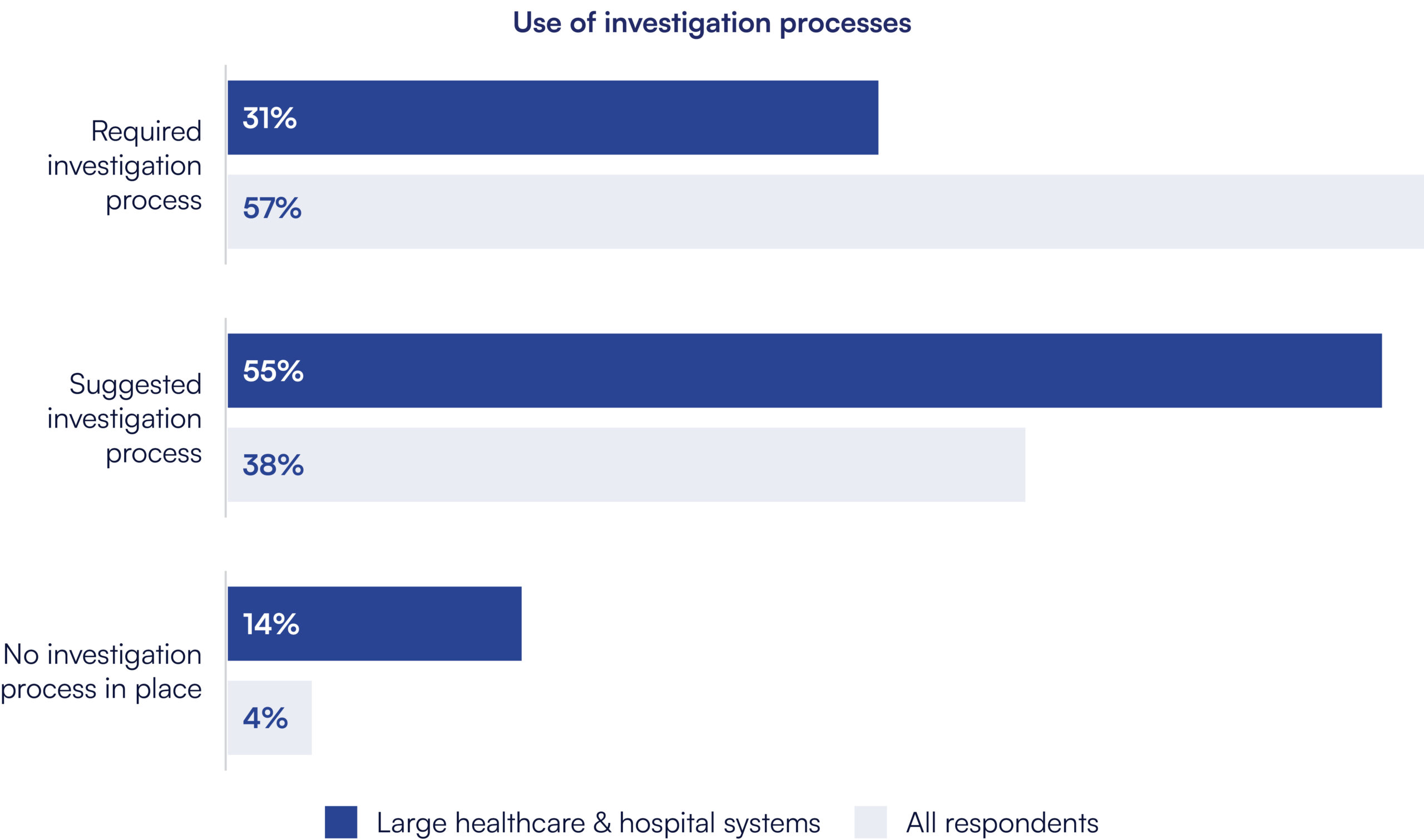
Substantiation Rates
Tracking substantiation rates is fundamental to understanding the effectiveness and fairness of workplace investigations. Many large healthcare & hospital systems recognize the value of monitoring overall substantiation rates, yet few analyze this data by issue type, highlighting a missed opportunity to gain deeper insights into patterns and potential areas of concern that might otherwise go unnoticed. Ongoing analysis and consistent monitoring of this data allows organizations to proactively address specific risks and implement targeted interventions, strengthen accountability and foster a culture of trust.
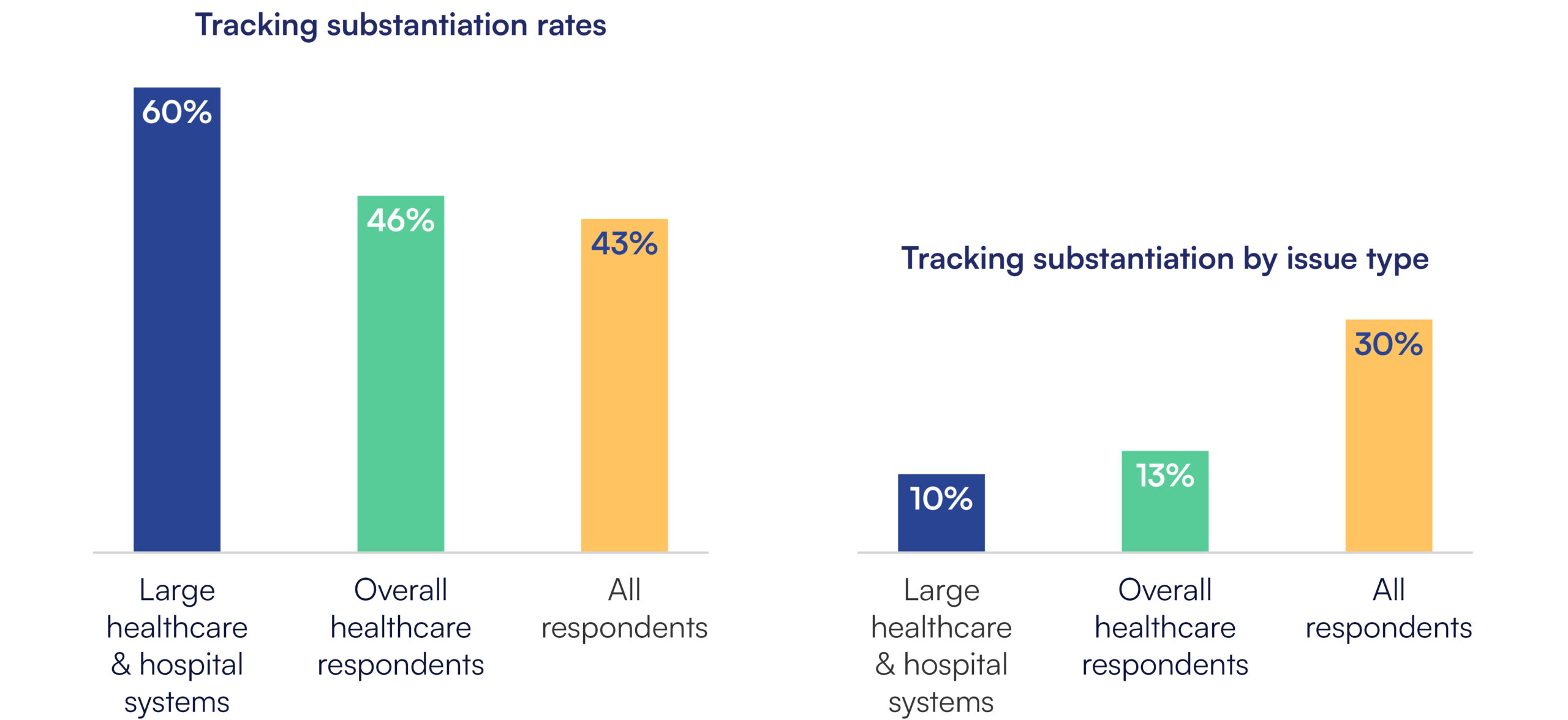
Using Data & Analytics
Tracking and Using Data & Metrics
Large healthcare and hospital systems are moving away from outdated tools, yet many still haven’t adopted dedicated case management software to manage employee relations and workplace investigations. This limits their ability to turn data into actionable insights, identify training needs or proactively address inclusion and equity. Without robust tracking and analytics, organizations risk missing early warning signs. Investing in technology specifically designed to manage employee relations is essential for driving strategic, data-informed decisions and fostering a culture of trust.
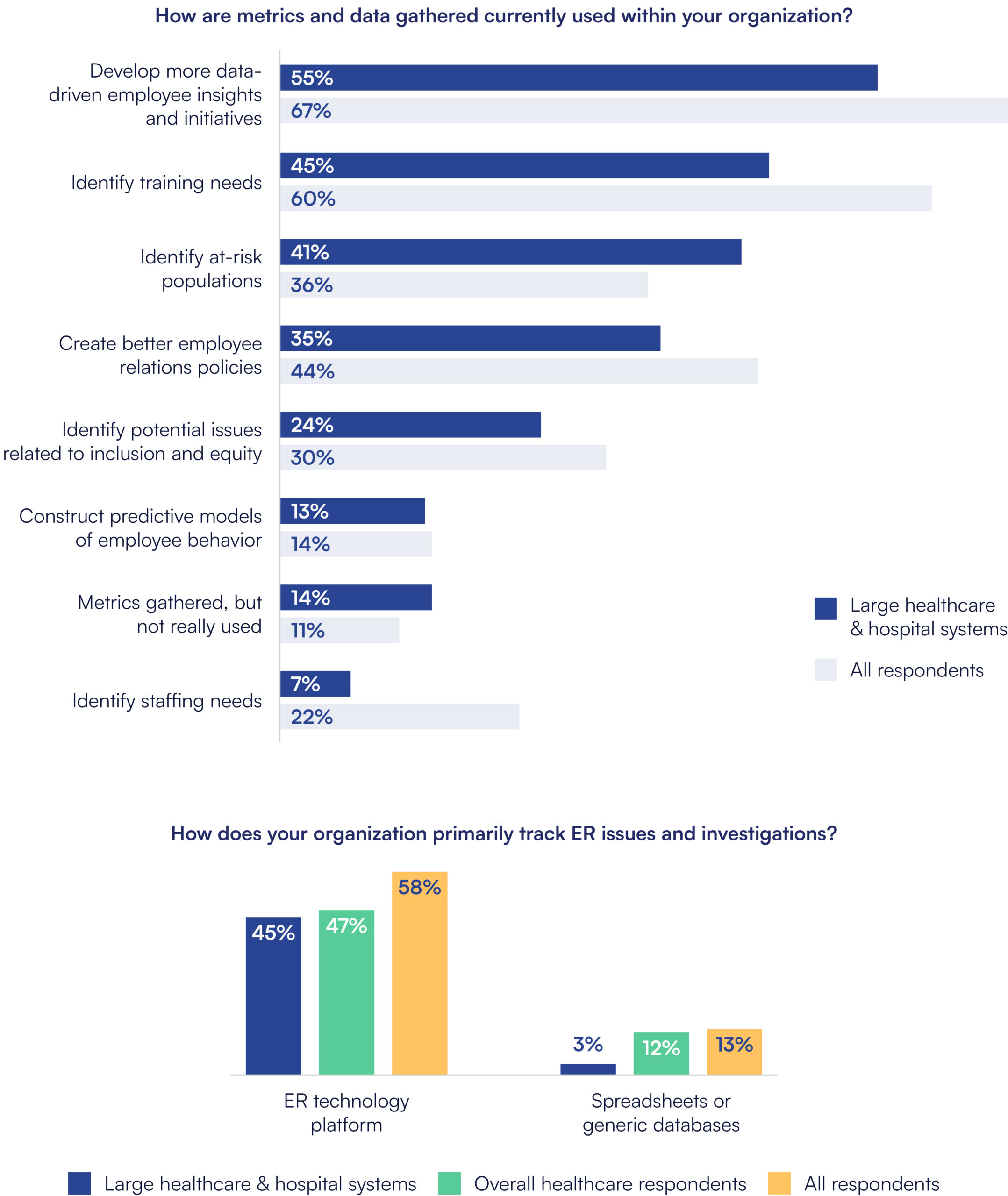
Advanced Analytics
When it comes to tracking key employee data points such as demographics, performance ratings, turnover and engagement scores, organizations in this segment are ahead of the overall respondent curve, giving them a stronger foundation for understanding workforce trends and addressing employee relations issues. However, there’s still room to grow in connecting employee relations with broader business performance and talent management strategies. By integrating these additional data streams, organizations can more effectively manage the nuances of employee relations, drive better outcomes and align people practices with overall business goals.
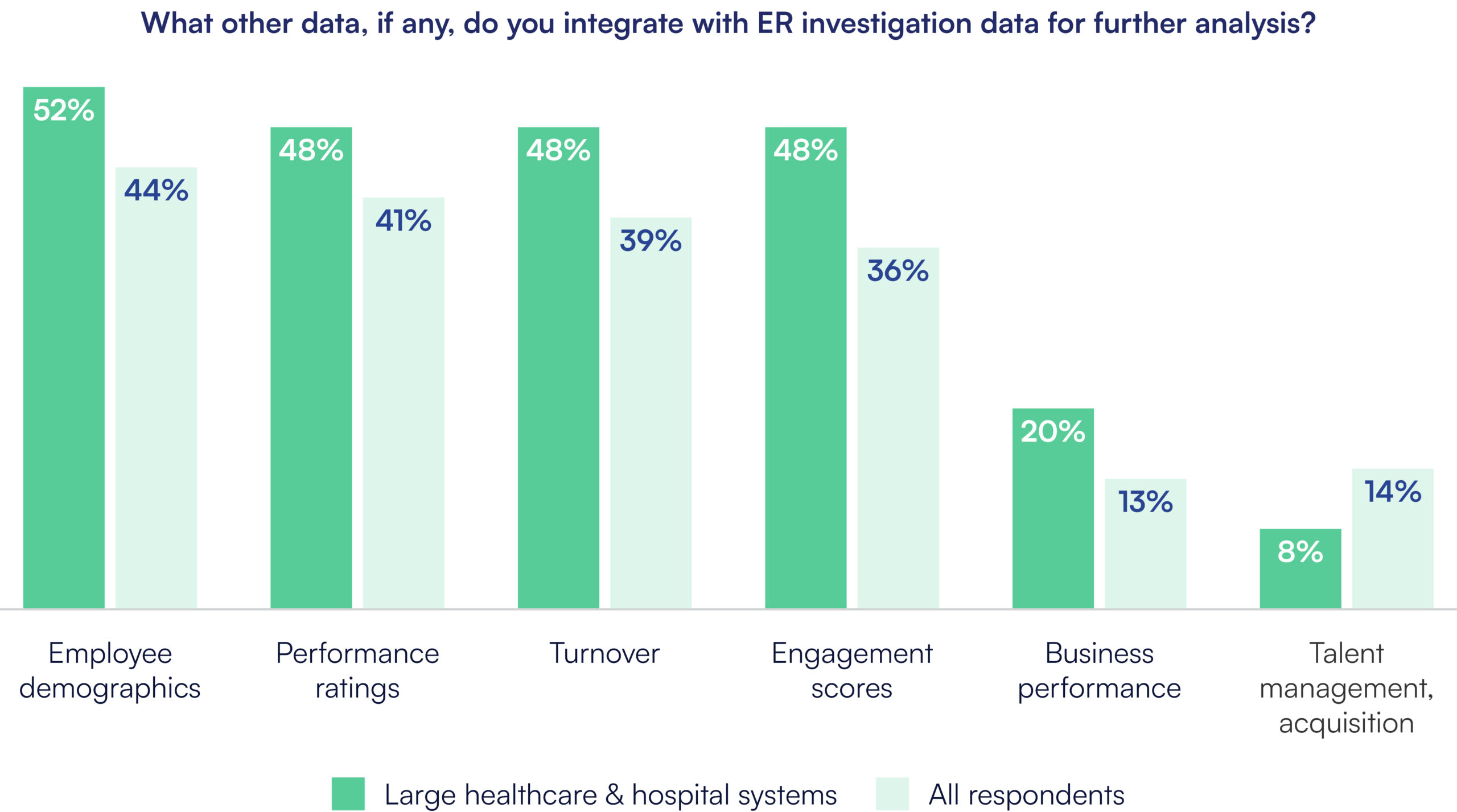
Predictive Analytics
The data shows a mixed approach to using analytics in employee relations. While a strong majority proactively identify early warning flags and measure the impact of their initiatives, fewer leverage predictive data to spot incidents before they escalate or implement initiatives in response to trends. Interestingly, more large healthcare & hospital systems are building models to predict employee behavior and forecast outcomes than the overall average, yet a greater portion collects data without fully analyzing or acting on it. To manage employee relations effectively, it’s essential to move from data collection to actionable insights — using predictive analytics and targeted interventions to get ahead of issues and drive meaningful change.
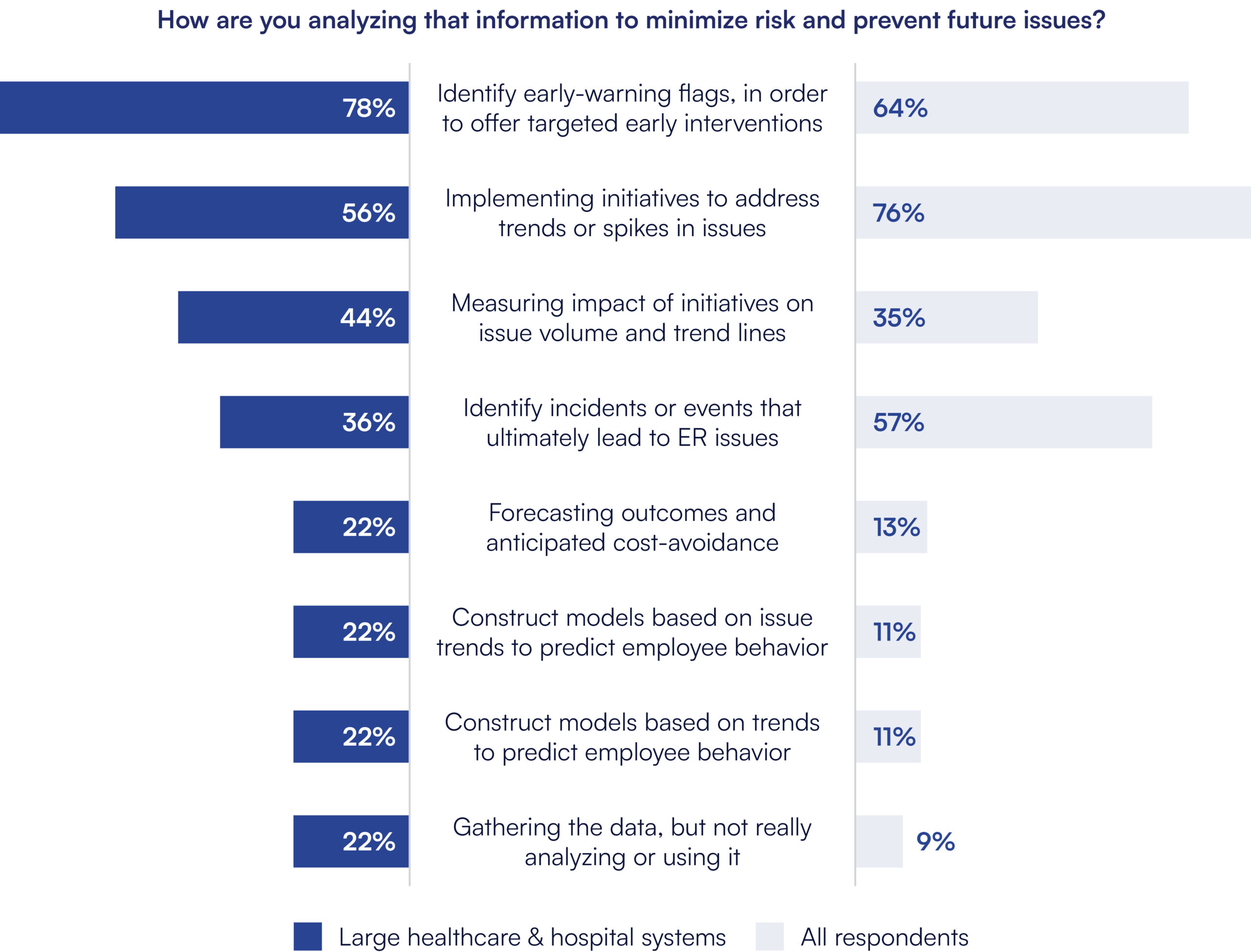
Artificial Intelligence
The data reveals that while some organizations in this sector are beginning to use AI for policy recommendations and pilot isolated AI projects, adoption remains cautious and measured. A thoughtful strategy that reflects best practices, emphasizes the importance of ethics, transparency and fairness in AI implementation is essential for employee relations. Effective experimentation is best started with small, well-defined projects, includes rigorous oversight to identify and address bias, and engages diverse stakeholders throughout the process. In this way, organizations can responsibly harness AI’s potential to create efficiencies and strengthen employee relations effectiveness. Balancing AI-driven insights while keeping human judgment central helps build trust with employees and safeguards the organization.
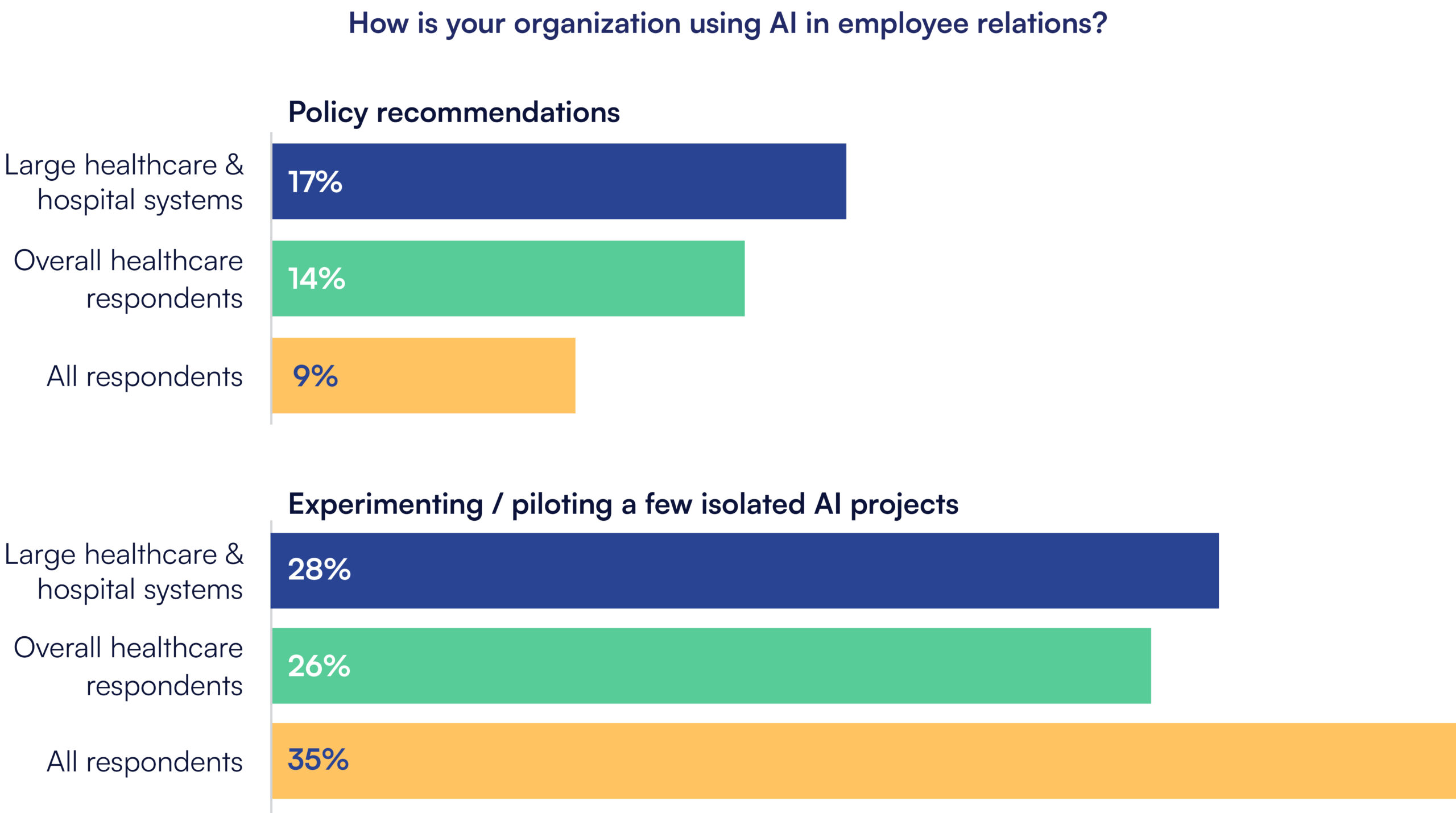
Healthcare Industry Perspectives
Driving Strategic Impact with Data Insights
- “Identified areas of increased staffing shortages; investigations help us identify issues before they turn into litigation cases.”
- “Use data for compliance committee reporting quarterly.”
- “We began a new focus on leader capability; Reconstructed all leader training around employee relations trends and data; Leaders now feel more supported and kept abreast.”
- “Examining our data has helped create more efficient processes and align our work with the industry.”
- “As we centralized, leaders and ER Center of Excellence (COE) spent lots of time on repetitive task of Attendance Disciplinary action; Created standardized attendance forms with plug-and-play fields to streamline the process for operational leaders to enable quick ER COE review.”
- “Secured an additional Full-Time Equivalent (FTE) for our Disability Management Staff (responsible for Americans with DIsabilities Act compliance).”
- “Determined that nearly 50% of cases could be handled locally with proper guidance; Created an intake system to ensure leaders complete all steps before escalating cases.”
- “Analyzed overtime, absences and disciplinary action to predict staffing levels.”
- “Delving into data helped us uncover communication gaps and identify needs and opportunities to improve consistency.”
- “Share monthly and Year-to-Date ER data on Performance Notices and cases, as well as trends and watchlist items.”
Embracing AI’s Potential in Employee Relations
- “We realized great time savings when recently completing our Annual Reviews and setting goals for next year with the help of AI.”
- “It’s mostly used in business areas that HR supports; we’ll most likely first implement AI in our HR Resource Center.”
- “We realized great time savings when recently completing our Annual Reviews and setting goals for next year with the help of AI.”
- “While in early stages, we hope to leverage AI in the coming year to increase efficiency, automate administrative tasks and mine our data for insights.”
About the Benchmark Study
The Annual HR Acuity Employee Relations Benchmark Study was launched in 2016 to identify and define best practices for employee relations management. Organizations across a wide array of industries provide data on employee relations practices related to their organizational model, case management processes, employee issue types, volumes, trends and internal data-driven metrics. The Study continues to grow in breadth of topics and the number of participating organizations. We continue to work with participants and members of the HR Acuity Employee Relations Roundtable and empowER™ communities to refine and expand the instrument to include relevant topics on which practitioners seek benchmarking information. The Study is the definitive resource for employee relations management and trends across the evolving landscape, providing best practices and metrics for organizations to compare their employee relations function against similarly situated organizations.
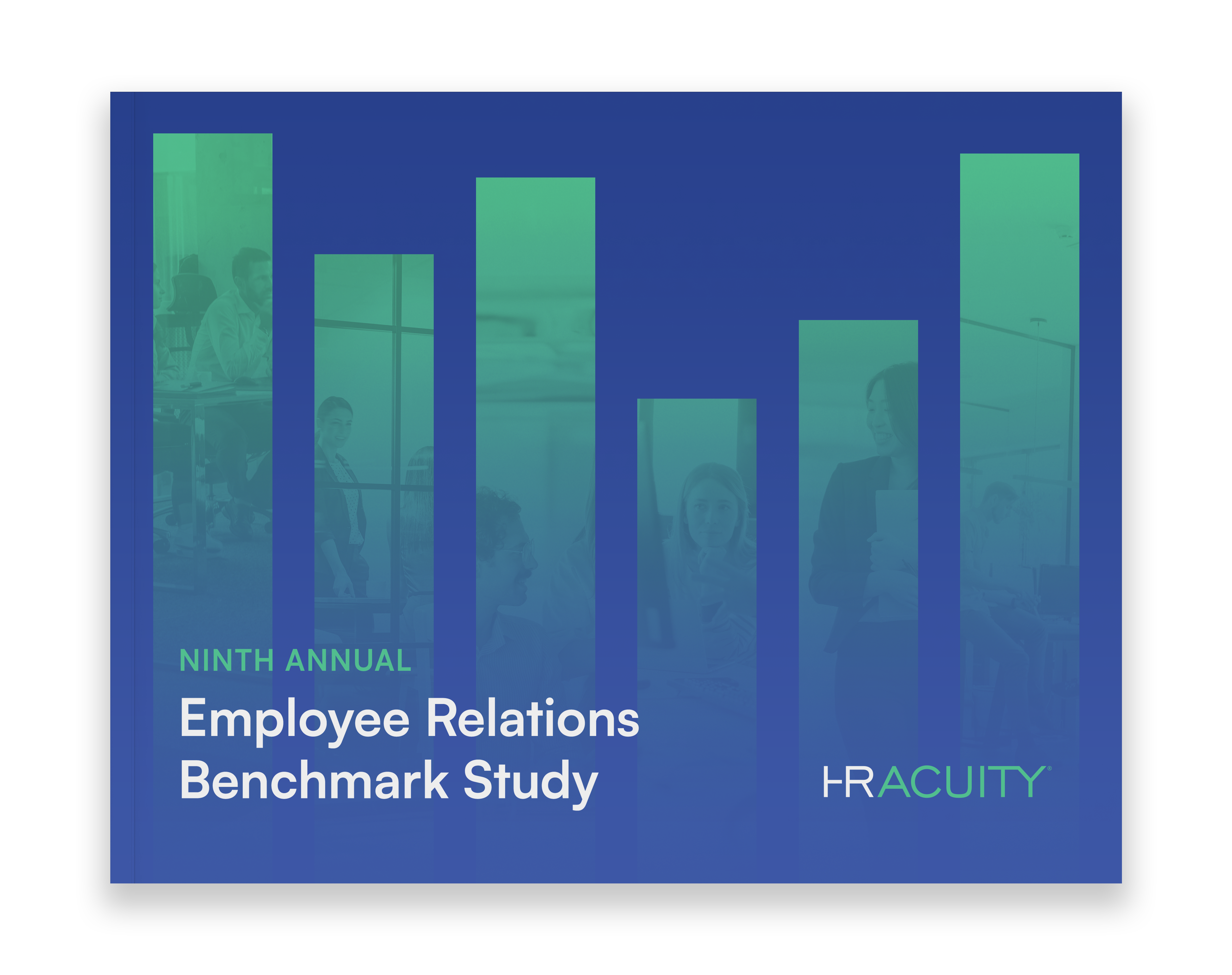
Interested in participating in next year’s study? Email us at benchmark@hracuity.com to let us know.
Research Links:
- Visit the DOI for this year’s Benchmark
- Visit Deb Muller’s ORCID Profile
